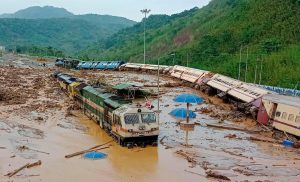On 23 July, India’s finance minister Nirmala Sitharaman specified a major outlay for flood control during her speech on the 2024-2025 budget. The north-eastern state of Bihar was assigned INR 115 billion (USD 1.4 billion) to build flood mitigation projects, while the states of Assam, Himachal Pradesh, Uttarakhand and Sikkim were mentioned without specified allocations. In the weeks after the speech, a series of flood-related disasters have served as a grim confirmation that India needs to urgently focus on managing floods.
On 30 July, the southern state of Kerala witnessed one of its worst natural disasters. Flash flooding and landslides led to at least 231 deaths, and approximately 700 homes and businesses buried under debris. The next day, at the other end of India, a series of cloudbursts hit Himachal Pradesh in the north, leading to at least a dozen dead, many dozens missing, and damage to bridges, roads, hydropower infrastructure and hundreds of buildings.
To the east, Assam had already reported 117 killed due to floods by 25 July, with 18,000 people affected by 2 August. And just this week, the western state of Gujarat has faced a deluge, leaving at least 35 dead and roughly 8,500 relocated as of 29 August.
The sheer scale and spread of these disasters has left the flood management portion of Sitharaman’s speech and latest budget looking paltry and belated. Death and destruction wrought by flooding is not a new phenomenon in the states affected. Last year, flash floods in Himachal Pradesh led to the deaths of 367 people and millions in damages. In July, the union minister of state for home affairs, Nityanand Rai, informed parliament that 880 people had died in Assam’s floods during the past five years.
Sitharaman’s speech made no mention of flood zoning, the process of identifying and categorising areas based on their vulnerability to flooding. This often involves mapping flood-prone areas and setting regulations on construction and land use to minimise damage during flood events. Despite its importance, many Indian states have yet to implement flood zoning, contributing to repeated disasters.
Part of the problem is that 70% of India’s annual rainfall is between June and September, the four main months of monsoon. This severe concentration inevitably causes rivers to expand far beyond their typical footprints. A complicating issue in the north is the Himalayas, the comparatively young mountain range created by the subcontinent pushing into Asia. Himalayan rivers are steep and carry a heavy sediment load. When they reach the plains, their speed and sediment make them prone to spreading, which can change river courses.
Adding to these challenges is climate change. As the atmosphere heats up, it has a specific impact on rainfall: warmer air can hold more water, and so rainfall is less frequent but more intense. Longer periods of steady rain are changing to shorter bursts of heavy rain.
Follow the money
A closer look at these disasters indicates it is not just these issues that are the problem. Or that large, flood-mitigation infrastructure projects have simply failed to deal with the issue. (More than 3,800 kilometres of embankments have been built in Bihar over the decades, but the flooding persists.) There are other mitigation efforts, but they are being ignored.
For example, in 2011, the Western Ghats Ecology Expert Panel expressly asked that some of the areas of Kerala be made eco-sensitive zones. This would have prohibited any new heavy infrastructure or buildings. Some of those areas were affected by floods this year.
The damage to hydropower plants in Himachal Pradesh during 2023 and 2024 indicates these large infrastructure projects were not designed with such challenges in mind. The flooding of Assam’s capital, Guwahati, on 5 August also seems linked to infrastructure projects and their impact on drains, according to locals – although the chief minister of Assam blamed a university in the neighbouring, upstream state of Meghalaya for carrying out a “flood jihad”.
None of the states that suffered major disasters this year had done flood zoning. In fact, in 2022, the Ministry of Jal Shakti (which manages water issues) complained that only Manipur, Rajasthan, Uttarakhand and the erstwhile state of Jammu & Kashmir had legislated for flood zoning. And even in those places, the flood plains were yet to be demarcated. Two years later, the Ministry of Jal Shakti is once again briefing the press on how state governments are not acting.
One of the major funding avenues of political parties would be deeply – and negatively – affected if Indian states became serious about flood zoning
One reason may be that flood zoning comes at a cost, and that cost affects a major funder of political parties: real estate. In the United States, flood zones mean lower demand and higher insurance costs for real estate companies. In fact, because many property developers are not pricing in flood risk, it has been estimated that the US housing market is overvalued by USD 121-237 billion.
If flood zoning was effectively implemented in India, it would inevitably impact real estate, depressing prices as people realised the risks of buying properties in those areas. And real estate companies in India are deeply entwined with political parties. Last year, India’s supreme court invalidated the secrecy surrounding electoral bonds, which enable the funding of political parties through purchasing bonds. The real estate sector was subsequently revealed to have bought INR 9.2 billion in electoral bonds.
Put simply, one of the major funding avenues of political parties would be deeply – and negatively – affected if Indian states became serious about flood zoning.
As climate change increases the frequency and intensity of floods in India, its citizens have to ask themselves if they are comfortable with the status quo. The solutions offered by politicians, in the form of infrastructure projects, have not helped. The solutions advocated by the bureaucrats are not being implemented. In the meantime, people continue to die, and their properties are destroyed, as floods – in areas known to be flood-prone but where houses and infrastructure keep being built – wreak havoc again and again.









